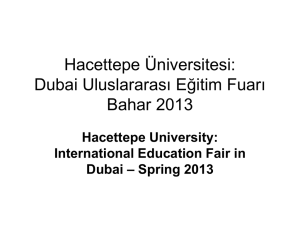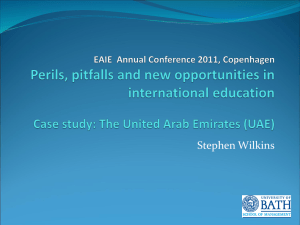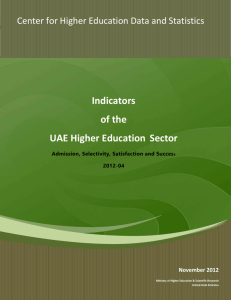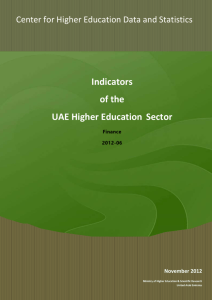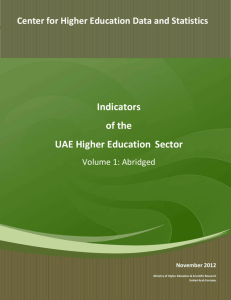UAE Higher Education Sector Indicators Report 2012
advertisement
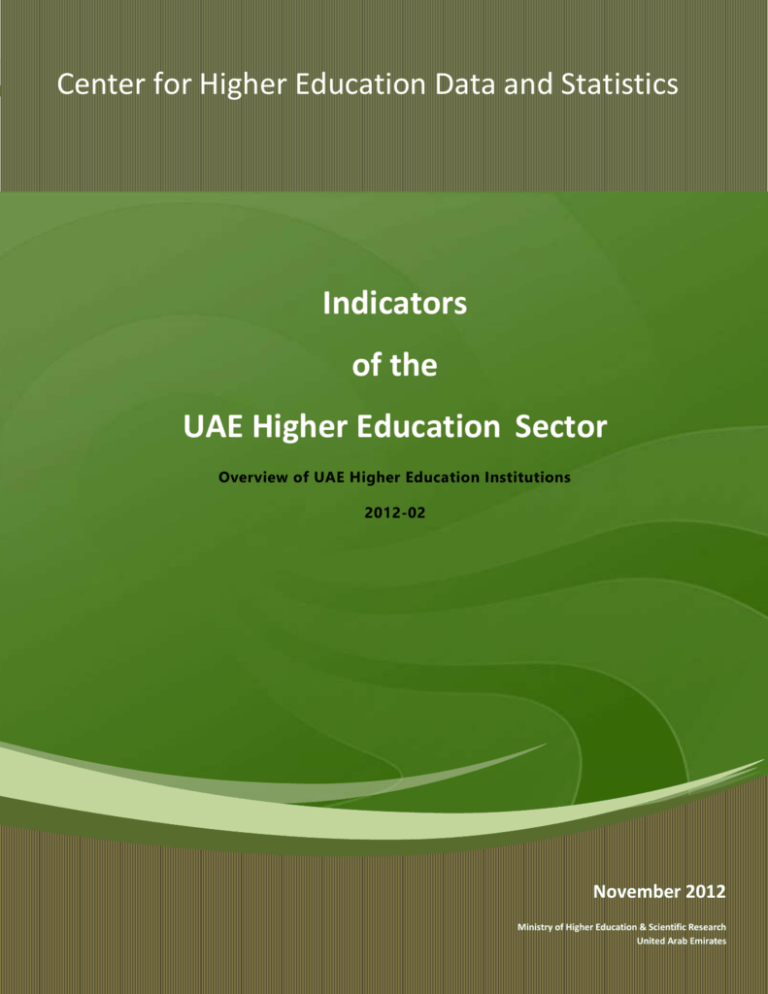
Indicators of the UAE HE Sector Center for Higher Education Data and Statistics Indicators of the UAE Higher Education Sector Overview of UAE Higher Education Institutions 2012-02 November 2012 1 Ministry of Higher Education & Scientific Research United Arab Emirates Indicators of the UAE HE Sector 2 Indicators of the UAE HE Sector CENTER FOR HIGHER EDUCATION DATA AND STATISTICS (CHEDS) INDICATORS OF THE UAE HIGHER EDUCATION SECTOR 2012 3 Indicators of the UAE HE Sector CHEDS Publication 2012: 02 What is CHEDS? The Center for Higher Education Data and Statistics (CHEDS), located within the Commission for Academic Accreditation in the Ministry of Higher Education and Scientific Research, is the national body for the collection, analysis and reporting of data on higher education in the UAE. © 2012 Center for Higher Education Data and Statistics Ministry of Higher Education and Scientific Research PO Box 45133 Abu Dhabi United Arab Emirates www.cheds.ae 4 Indicators of the UAE HE Sector Overview of UAE Higher Education Institutions, November 2012 At the time of writing this report (October 2012), there are 102 higher education institutions (HEIs) in the country. The precise number varies rather often as new institutions are created and others close or merge. Within this constituency are many different varieties of institut ions, including private and governmental, for-profit and not-for-profit, and institutions having different types of recognition. Some are solely based in the UAE, while others are branches of institutions from other countries. There are three institutions supported by the federal government (Higher Colleges of Technology, UAE University and Zayed University), and referred to as ‘federal institutions’, there are institutions that are licensed by the CAA and institutions that are not. Some institutions are located within a recognized free zone in Dubai or Ras Al Khaimah. These various categories overlap, and are listed in Table 1. T ABLE 1: DISTRIBUTION OF OPERATIONS OF HIGHER EDUCATION INSTITUTIONS OVER THE SEVEN EMIRATES ( SEPTEMBER 2012). TYPE NO. EMIRATE OF OPERATION ( MAIN CAMPUS OR HAVING BRANCH CAMPUS) ABU RAS AL DHABI DUBAI SHARJAH 3 3 2 1 Operational 59 20 (4) 28 (1) Private Establishment 7 1 status Stage 6 SUB TOTAL not CAA-licensed - Free zone Federal CAA- AJMAN UMM AL KHAIMAH FUJAIRAH QUWAIN X 1 1 X 6 (2) 4 3 2 (3) X 3 1 1 X X 1 4 1 1 X X X X 75 28 34 9 5 4 3 1 27 X 21 X X 6 X X 102 29 56 8 5 10 3 1 licensed - CAA-licensed - other (5) or others GRAND TOTAL (1) Includes University of Strathclyde Business School, UAE (2) Includes Khalifa University of Science, Technology & Research, Sharjah campus (3) Includes Ajman University campus (4) Includes campus of EIBFS (5) Institutions for the uniformed services The spread of institutions across the seven emirates is shown in Fig. 1. 5 Indicators of the UAE HE Sector The federal institutions serve the whole country from different locations. UAE University (UAEU) operates in Al Ain, Zayed University (ZU) operates in Abu Dhabi and Dubai, and the Higher Colleges of Technology (HCT) operate 16 campuses in six cities, namely Abu Dhabi, Al Ain, Dubai, Sharjah, Ras Al Khaimah, and Fujairah. Each institution offers Foundation, Bachelor and Master programs. In addition, UAEU offers PhD programs, while HCT offers Readiness, Diploma, and Higher Diploma programs. Their enrolment has increased by 22% from 2008/9 (33,144 students) to 2011/12 (40,433 students). This represents 37% of the enrolments at institutions recognized by MOHESR. See Fig. 2 for more detail. 6 Indicators of the UAE HE Sector CAA-licensed institutions are private, non-federal, entities, regulated by the standards of the Commission for Academic Accreditation of the federal Ministry of Higher Education and Scientific Research. They are not funded by the federal government but some benefit from emirate funding. Among CAA institutions are semi-government institutions, independent private institutions, and branch campuses of international institutions. The number of CAA-licensed institutions has increased from 54 to 74 in the last 5 years (2008-2011). In the same period, enrollments at licensed institutions have increased from 52,926 to 69,509, an increase of 31% (excluding specialized Police, Aviation and Naval Colleges). Six of the 74 institutions are in the establishment stage, and 12 are branch campuses of international institutions. Non CAA-licensed free zone branch campuses are institutions operating under emirate legislation, but without a federal license, within recognized free zones in Dubai and RAK. There are 23 in Dubai, enrolling 13,000 students (according to the Dubai Bureau of Statistics), and five in Ras Al Khaimah. The great majority of these institutions (25 of 28) are branch campuses of international institutions, offering instruction toward degrees awarded by the home campus. T ABLE 2: C OUNTRIES OF HOME INSTITUTIONS OF FREE ZONE BRANCH CAMPUSES FREE ZONE UK USA INDIA AUSTRALIA FRANCE RUSSIA PAKISTAN IRAN SWITZERLAND NONE DUBAI 8 3 4 2 1 1 1 1 0 2** RAS AL KHAIMAH 1 3 0 0 0 0 0 1 0 ** Allied Institute of Management Studies and National Institute of Vocational Education are not branches of a foreign institution Clusters of Institutions CHEDS has computed indicators for 12 clusters of institutions which were identified using the following clustering criteria across four dimensions: Level of programs offered: (up to Diploma, Bachelor degree, Master Degree, and Doctoral programs) (clusters 1-4) Size of institution : Small (<1,000 students), Medium (1,000 to 3,999 students), and Large (>3,999 students) (clusters 5-7) the Federal institutions and the CAA-licensed institutions (clusters 8-9) Location of main campus: Abu Dhabi, Dubai, and Northern Emirates (Clusters 10-12) Tables 3 & 4 give the values of selected indicators for these clusters. T ABLE 3: S ELECTED INDICATORS FOR C LUSTERS 1-7 7 Indicators of the UAE HE Sector Level of study Indicator Enrolment Size of institution Diploma BS MSc PhD Small Medium Large Revenue/student 37,168 53659 67759 78751 91353 68813 63496 Expenditure/student 35,260 54202 63919 82024 93257 64871 63350 Financial Aid/student 192 375 3394 1994 2507 1902 2078 Average number of programs 4.9 5.2 13.8 39.0 5.9 15.5 48.3 Average number of international accreds 0 0.7 1.0 1.4 0.6 0.4 3.1 Number books/student 10 43 25 35 49 12 37 Number Journals / area 9 1,889 375 3,766 1,649 1,484 949 Library funds/student 494 138 1,049 651 1,143 1,205 537 Student satisfaction 0.75 0.84 0.73 0.68 0.71 0.75 0.76 Graduate satisfaction 0.73 0.67 0.61 0.56 0.61 0.64 0.59 Ratio of offered places to number of applicants 0.84 0.60 0.56 0.65 0.27 0.75 0.80 Progress rate 0.81 0.76 0.83 0.81 0.82 0.83 0.79 Success rate Teaching load/week (assistant & above) 0.87 16.4 0.96 14.6 0.90 10.7 0.91 10.4 0.89 7.8 0.85 11.6 0.93 13.6 Teaching load/week (lecturers) 6.3 16.7 4.4 1.5 5.8 8.3 7.4 Faculty satisfaction 0.68 0.69 0.67 0.79 0.67 0.69 0.77 Student / Faculty ratio 20.0 17.1 16.4 14.7 9.71 20.00 17.20 Proportion PT to FT Publication score 0.21 0.24 0.18 0.35 0.25 0.79 0.14 0.62 0.32 0.92 0.34 0.87 0.12 0.59 % of UAE National Students 0.71 0.86 0.40 0.53 0.38 0.50 0.65 % of Faculty -PhD Holders 0.12 0.26 0.66 0.66 0.57 0.63 0.52 T ABLE 4: S ELECTED INDICATORS FOR C LUSTERS 8-12 Type of institution Location Dubai Emirate 58122 51415 Federal 74,067 79,064 CAA-licensed 62563 58469 Abu Dhabi Emirate 75114 78932 Financial Aid/student Average number of progs Average number of international accreds Number books / student 433 54 3160 11 980 17 1664 9 4353 15 6.0 41 0.6 25 1.3 40 1.0 17 0.5 23 Number Journals / area Library funds/student Student satisfaction 268 627 0.86 22,785 742 0.72 2,222 803 0.78 1,228 528 0.76 67 573 0.72 Indicator Revenue/student Expenditure/student Northern Emirates 56020 50223 8 Indicators of the UAE HE Sector Graduate satisfaction Ratio of offered places to number of applicants Progress rate Success rate Teaching load/week (assistant & above) Teaching load/week (lecturers) Faculty satisfaction 0.73 0.60 0.63 0.66 0.56 0.75 0.73 0.95 0.57 0.83 0.90 0.61 0.75 0.94 0.51 0.82 0.85 0.70 0.87 0.90 10.9 10.7 11.8 11.0 11.0 4.6 0.87 6.1 0.70 7.7 0.72 9.9 0.65 5.0 0.73 Student / Faculty ratio Proportion PT to FT Publication score % of UAE National Students % of Faculty PhD Holders 15.8 0.05 0.53 17.9 0.30 0.73 17.3 0.08 0.62 20.5 0.52 0.77 16.0 0.27 0.62 0.91 0.41 0.43 0.65 0.80 0.46 0.42 0.73 0.35 0.65 9
